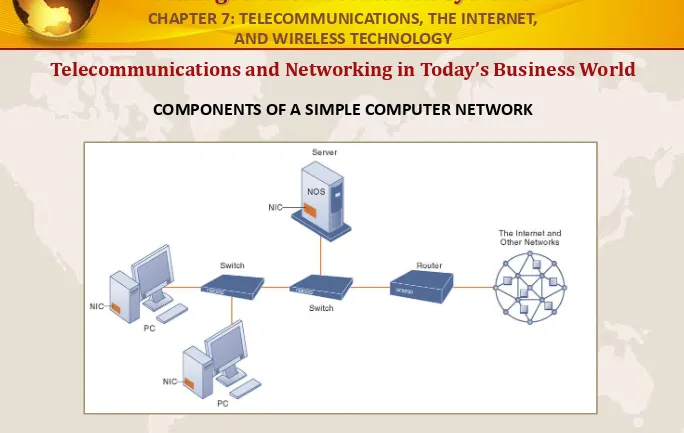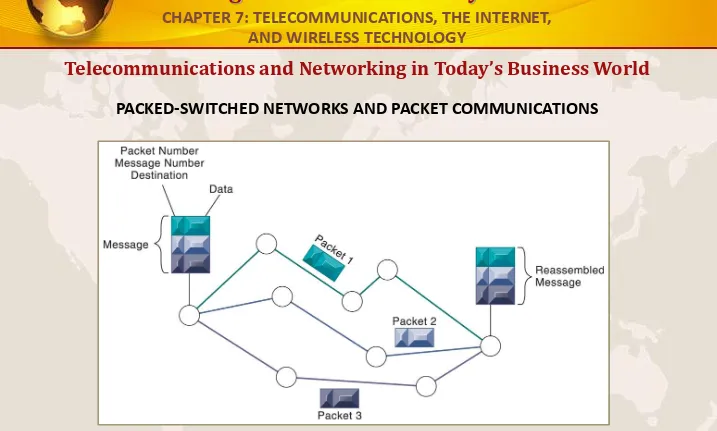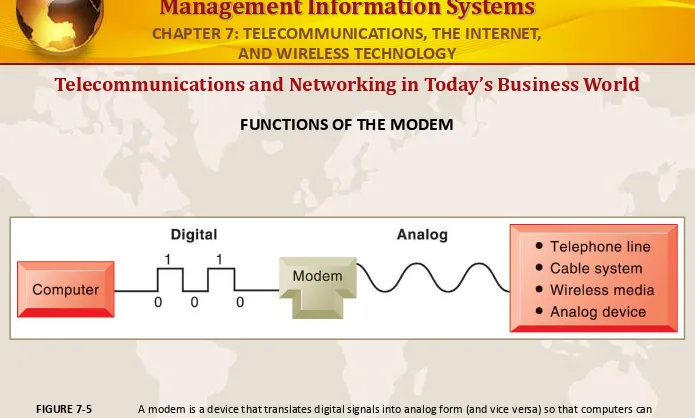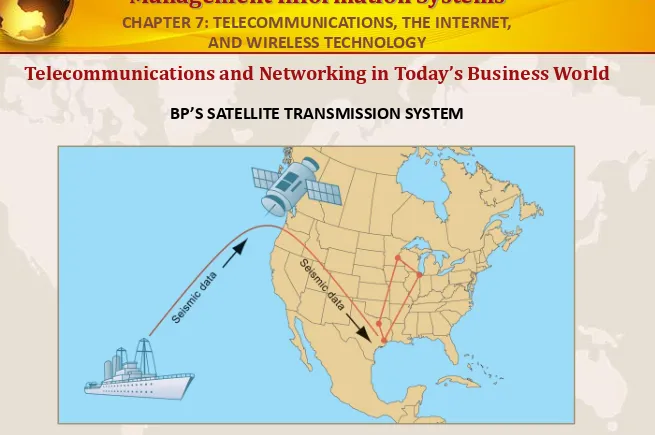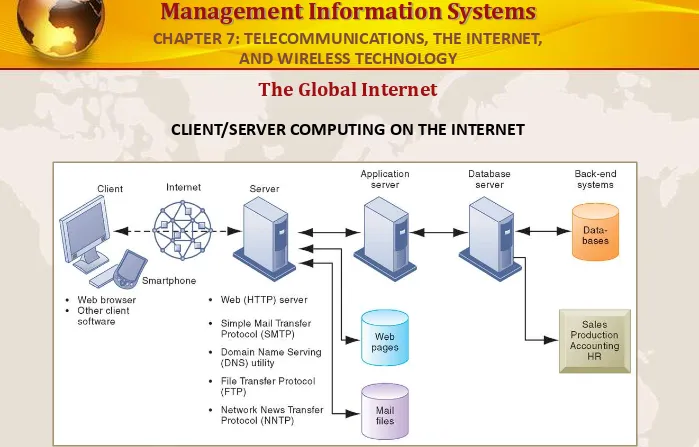Management Information Systems
MANAGING THE DIGITAL FIRM, 12
THEDITION GLOBAL EDITION
TELECOMMUNICATIONS, THE
INTERNET,
AND WIRELESS TECHNOLOGY
Chapter 7
VIDEO CASES
Case 1: Traveling the Internet and Wireless Technology
Case 2: Unified Communications Systems With Virtual Collaboration: IBM and Forterra
Instructional Video 1: AT&T Launches Managed Cisco Telepresence Solution
Management Information Systems
•
What are the principal components of telecommunications
networks and key networking technologies?
•
What are the main telecommunications transmission media
and types of networks?
•
How does the Internet and Internet technology work and
how do they support communication and e-business?
•
What are the principal technologies and standards for
wireless networking, communication, and Internet access?
•
Why are radio frequency identification (RFID) and wireless
sensor networks valuable for business?
Learning Objectives
Management Information Systems
•
Problem:
Shipbuilding space is too large (4.2 sq mi)
and complex to track inventory in real-time, limiting
efficiency
•
Solution:
High-speed wireless network built by KT
Corp, using radio sensors, notebooks, mobiles, Web
cams
•
Illustrates:
–
Powerful capabilities and solutions offered by
contemporary networking technology
–
Use of radio sensor technologies to track inventory
Hyundai Heavy Industries Creates A Wireless Shipyard
Management Information Systems
•
Networking and communication Trends
–
Convergence:
•
Telephone networks and computer networks converging into
single digital network using Internet standards
•
E.g. cable companies providing voice service
–
Broadband:
•
More than 60% U.S. Internet users have broadband access
–
Broadband wireless:
•
Voice and data communication as well as Internet access are
increasingly taking place over broadband wireless platforms
Telecommunications and Networking in Today’s Business World
Management Information Systems
•
What is a computer network?
–
Two or more connected computers
–
Major components in simple network
•
Client computer
•
Server computer
•
Network interfaces (NICs)
•
Connection medium
•
Network operating system
•
Hub or switch
–
Routers
•
Device used to route packets of data through different networks,
ensuring that data sent gets to the correct address
Telecommunications and Networking in Today’s Business World
Management Information Systems
Telecommunications and Networking in Today’s Business World
COMPONENTS OF A SIMPLE COMPUTER NETWORK
Illustrated here is a very simple computer network, consisting of computers, a network operating system residing on a dedicated server computer, cable (wiring) connecting the devices, network interface cards (NICs), switches, and a router.
FIGURE 7-1
Management Information Systems
•
Components of networks in large companies
–
Hundreds of local area networks (LANs) linked to
firmwide corporate network
–
Various powerful servers
•
Web site
•
Corporate intranet, extranet
•
Backend systems
–
Mobile wireless LANs (Wi-Fi networks)
–
Videoconferencing system
–
Telephone network
–
Wireless cell phones
Telecommunications and Networking in Today’s Business World
Management Information Systems
Telecommunications and Networking in Today’s Business World
CORPORATE
NETWORK
INFRASTRUCTURE
Today’s corporate network
infrastructure is a collection of many different networks from the public switched telephone network, to the Internet, to corporate local area networks linking workgroups,
departments, or office floors.
FIGURE 7-2
Management Information Systems
•
Key networking technologies
–
Client/server computing
•
Distributed computing model
•
Clients linked through network controlled by network
server computer
•
Server sets rules of communication for network and
provides every client with an address so others can find
it on the network
•
Has largely replaced centralized mainframe computing
•
The Internet: Largest implementation of client/server
computing
Telecommunications and Networking in Today’s Business World
Management Information Systems
•
Key networking technologies (cont.)
–
Packet switching
•
Method of slicing digital messages into parcels
(packets), sending packets along different
communication paths as they become available, and
then reassembling packets at destination
•
Previous circuit-switched networks required assembly
of complete point-to-point circuit
•
Packet switching more efficient use of network’s
communications capacity
Telecommunications and Networking in Today’s Business World
Management Information Systems
Telecommunications and Networking in Today’s Business World
PACKED-SWITCHED NETWORKS AND PACKET COMMUNICATIONS
Data are grouped into small packets, which are transmitted independently over various communications channels and reassembled at their final destination.
FIGURE 7-3
Management Information Systems
•
Key networking technologies (cont.)
–
TCP/IP and connectivity
•
Connectivity between computers enabled by protocols
•
Protocols:
Rules that govern transmission of information between
two points
•
Transmission Control Protocol/Internet Protocol (TCP/IP)
–
Common worldwide standard that is basis for Internet
•
Department of Defense reference model for TCP/IP
–
Four layers
1. Application layer
2. Transport layer
3. Internet layer
4. Network interface layer
Telecommunications and Networking in Today’s Business World
Management Information Systems
Telecommunications and Networking in Today’s Business World
THE TRANSMISSION
CONTROL PROTOCOL/
INTERNET PROTOCOL
(TCP/IP) REFERENCE
MODEL
This figure illustrates the four layers of the TCP/IP reference model for communications
FIGURE 7-4
Management Information Systems
•
Signals: digital vs. analog
–
Modem: Translates digital signals into analog form
•
Types of networks
–
Local-area networks (LANs)
•
Campus-area networks (CANs)
•
Peer-to-peer
•
Topologies: star, bus, ring
–
Metropolitan and wide-area networks
•
Wide-area networks (WANs)
•
Metropolitan-area networks (MANs)
Telecommunications and Networking in Today’s Business World
Management Information Systems
Telecommunications and Networking in Today’s Business World
FUNCTIONS OF THE MODEM
A modem is a device that translates digital signals into analog form (and vice versa) so that computers can transmit data over analog networks such as telephone and cable networks.
FIGURE 7-5
Management Information Systems
Telecommunications and Networking in Today’s Business World
NETWORK
TOPOLOGIES
The three basic network topologies are the star, bus, and ring.
FIGURE 7-6
Management Information Systems
•
Physical transmission media
–
Twisted wire (modems)
–
Coaxial cable
–
Fiber optics and optical networks
•
Dense wavelength division multiplexing (DWDM)
–
Wireless transmission media and devices
•
Microwave
•
Satellites
•
Cellular telephones
–
Transmission speed (hertz, bandwidth)
Telecommunications and Networking in Today’s Business World
Management Information Systems
Telecommunications and Networking in Today’s Business World
BP’S SATELLITE TRANSMISSION SYSTEM
Communication satellites help BP transfer seismic data between oil exploration ships and research centers in the United States.
FIGURE 7-7
Management Information Systems
•
What is the Internet?
•
Internet Addressing and Architecture
–
The Domain Name System
•
Hierarchical structure
•
Top-level domains
–
Internet Architecture and Governance
•
No formal management: IAB, ICANN, W3C
–
The Future Internet: IPv6 and Internet2
The Global Internet
Management Information Systems
The Global Internet
THE DOMAIN NAME
SYSTEM
Domain Name System is a hierarchical system with a root domain, top-level domains, second-level domains, and host computers at the third level.
FIGURE 7-8
Management Information Systems
The Global Internet
INTERNET
NETWORK
ARCHITECTURE
The Internet backbone
connects to regional networks, which in turn provide access to Internet service providers, large firms, and government institutions. Network access points (NAPs) and
metropolitan area exchanges (MAEs) are hubs where the backbone intersects regional and local networks and where backbone owners connect with one another.
FIGURE 7-9
Management Information Systems
Read the Interactive Session and discuss the following questions
•
What is network neutrality? Why has the Internet operated
under net neutrality up to this point in time?
•
Who’s in favor of net neutrality? Who’s opposed? Why?
•
What would be the impact on individual users, businesses,
and government if Internet providers switched to a tiered
service model?
•
Are you in favor of legislation enforcing network neutrality?
Why or why not?
The Global Internet
THE BATTLE OVER NET NEUTRALITY
Management Information Systems
•
Internet services
–
–
Chatting and instant messaging
–
Newsgroups
–
Telnet
–
File Transfer Protocol (FTP)
–
World Wide Web
–
VoIP
–
Virtual private network (VPN)
The Global Internet
Management Information Systems
The Global Internet
CLIENT/SERVER COMPUTING ON THE INTERNET
Client computers running Web browser and other software can access an array of services on servers over the Internet. These services may all run on a single server or on multiple specialized servers.
FIGURE 7-10
Management Information Systems
The Global Internet
HOW VOICE OVER IP WORKS
An VoIP phone call digitizes and breaks up a voice message into data packets that may travel along different
routes before being reassembled at the final destination. A processor nearest the call’s destination, called a
gateway, arranges the packets in the proper order and directs them to the telephone number of the receiver or the IP address of the receiving computer.
FIGURE 7-11
Management Information Systems
The Global Internet
A VIRTUAL PRIVATE
NETWORK USING
THE INTERNET
This VPN is a private network of computers linked using a
secure “tunnel” connection
over the Internet. It protects data transmitted over the public Internet by encoding the
data and “wrapping” them
within the Internet Protocol (IP). By adding a wrapper around a network message to hide its content, organizations can create a private connection that travels through the public Internet.
FIGURE 7-12
Management Information Systems
Read the Interactive Session and discuss the following questions
•
Should managers monitor employee e-mail and
Internet usage? Why or why not?
•
Describe an effective e-mail and Web use policy for
a company.
•
Should managers inform employees that their Web
behavior is being monitored? Or should managers
monitor secretly? Why or why not?
The Global Internet
MONITORING EMPLOYEES ON NETWORKS: UNETHICAL OR GOOD BUSINESS?
Management Information Systems
•
The World Wide Web
–
HTML (Hypertext Markup Language):
•
Formats documents for display on Web
–
Hypertext Transfer Protocol (HTTP):
•
Communications standard used for transferring Web
pages
–
Uniform resource locators (URLs):
•
Addresses of Web pages
–
E.g. http://www.megacorp.com/content/features/082602.html
–
Web servers
•
Software for locating and managing Web pages
The Global Internet
Management Information Systems
•
The World Wide Web (cont.)
–
Search engines
•
Started in early 1990s as relatively simple software
programs using keyword indexes
•
Today, major source of Internet advertising revenue via
search engine marketing, using complex algorithms and
page ranking techniques to locate results
–
Shopping bots
•
Use intelligent agent software for searching Internet for
shopping information
The Global Internet
Management Information Systems
The Global Internet
HOW GOOGLE
WORKS
The Google search engine is continuously crawling the Web, indexing the content of each page, calculating its popularity, and storing the pages so that it can respond quickly to user requests to see a page. The entire process takes about one-half second.
FIGURE 7-13
Management Information Systems
The Global Internet
TOP U.S. WEB SEARCH ENGINES
Google is the most popular search engine on the Web, handling 72 percent of all Web searches.
FIGURE 7-14
Management Information Systems
•
Web 2.0
–
Four defining features
1. Interactivity
2. Real-time user control
3. Social participation
4. User-generated content
–
Technologies and services behind these features
•
Cloud computing
•
Blogs/RSS
•
Mashups & widgets
•
Wikis
•
Social networks
The Global Internet
Management Information Systems
The Global Internet
Management Information Systems
•
Cellular systems
–
Competing standards for cellular service
•
CDMA: United States
•
GSM: Rest of world, plus AT&T and T-Mobile
–
Third-generation (3G) networks
•
Suitable for broadband Internet access
•
144 Kbps
–
2Mbps
–
4G networks
•
Entirely packet-switched
•
100 Mbps
–
1Gbps
The Wireless Revolution
Management Information Systems
•
Wireless computer networks and Internet access
–
Bluetooth (802.15)
•
Links up to 8 devices in 10-m area
•
Useful for personal networking (PANs) and in business to
transmit data from handheld devices to other
transmitters
–
Wi-Fi (802.11)
•
Set of standards: 802.11a, 802.11b, 802.11g, 802.11n
•
Used for wireless LAN and wireless Internet access
•
Use access points: Device with radio receiver/transmitter
for connecting wireless devices to a wired LAN
The Wireless Revolution
Management Information Systems
The Wireless Revolution
A BLUETOOTH
NETWORK (PAN)
Bluetooth enables a variety of devices, including cell phones, PDAs, wireless keyboards and mice, PCs, and printers, to interact wirelessly with each other within a small 30-foot (10-meter) area. In addition to the links shown, Bluetooth can be used to network similar devices to send data from one PC to another, for example.
FIGURE 7-15
Management Information Systems
The Wireless Revolution
AN 802.11
WIRELESS LAN
Mobile laptop computers equipped with network interface cards link to the wired LAN by communicating with the access point. The access point uses radio waves to transmit network signals from the wired network to the client adapters, which convert them into data that the mobile device can understand. The client adapter then transmits the data from the mobile device back to the access point, which forwards the data to the wired network.
FIGURE 7-16
Management Information Systems
•
Wireless computer networks and Internet access
–
Wi-Fi (cont.)
•
Hotspots: Access points in public place to provide
maximum wireless coverage for a specific area
•
Weak security features
–
WiMax (802.16)
•
Wireless access range of 31 miles
•
Require WiMax antennas
•
Sprint Nextel building WiMax network as foundation for
4G networks
The Wireless Revolution
Management Information Systems
•
Radio frequency identification (RFID)
–
Use tiny tags with embedded microchips containing
data about an item and location, and antenna
–
Tags transmit radio signals over short distances to
special RFID readers, which send data over network
to computer for processing
–
Active RFID:
Tags have batteries, data can be
rewritten, range is hundreds of feet, more expensive
–
Passive RFID:
Range is shorter, also smaller, less
expensive, powered by radio frequency energy
The Wireless Revolution
Management Information Systems
•
Radio frequency identification (RFID) (cont.)
–
Common uses:
•
Automated toll-collection
•
Tracking goods in a supply chain
–
Requires companies to have special
hardware and software
–
Reduction in cost of tags making RFID
viable for many firms
The Wireless Revolution
Management Information Systems
The Wireless Revolution
HOW RFID WORKS
RFID uses low-powered radio transmitters to read data stored in a tag at distances ranging from 1 inch to 100 feet. The reader captures the data from the tag and sends them over a network to a host computer for processing.
FIGURE 7-17
Management Information Systems
•
Wireless sensor networks (WSNs)
–
Networks of hundreds or thousands of
interconnected wireless devices embedded into
physical environment to provide measurements of
many points over large spaces
•
Devices have built-in processing, storage, and radio
frequency sensors and antennas
•
Require low-power, long-lasting batteries and ability to
endure in the field without maintenance
–
Used to monitor building security, detect hazardous
substances in air, monitor environmental changes,
traffic, or military activity
The Wireless Revolution
Management Information Systems
The Wireless Revolution
A WIRELESS SENSOR
NETWORK
The small circles represent lower-level nodes and the larger circles represent high-end nodes. Lower level nodes forward data to each other or to higher-level nodes, which transmit data more rapidly and speed up network
performance.
FIGURE 7-18
